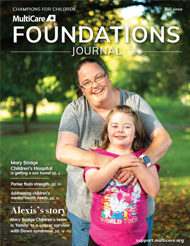Donations support 'life-like' trainings for new nurses and care teams

By McKenna Ownby
Ask any professional athlete what they do to improve after a big game, and you’ll most likely hear the same answer: they watch themselves on film.
MultiCare is applying that same methodology to professionals in the medical field, through an expansion of the Wagner Simulation Training Center at Tacoma General Hospital.
It’s a project that’s been in the making for the past two years, starting first at Tacoma General with plans to expand the same training advancements to all major MultiCare campuses.
The expansion—supported by contributions from generous community donors—consists of a few different components: enhanced technology, an advanced mock patient suite, and greater accessibility of simulation training equipment across MultiCare facilities.
 Together,
these advancements will provide staff with more realistic training experiences
in a “fail-safe” environment, resulting in higher quality care, improved safety
and better patient outcomes.
Together,
these advancements will provide staff with more realistic training experiences
in a “fail-safe” environment, resulting in higher quality care, improved safety
and better patient outcomes.
“From a learning perspective, we need to be very strategic about closing our gaps and staying ahead,” says Deb Genet, MultiCare’s Director of Education Services.
She’s been leading the charge for the expansion project since August 2018.
“The most important thing is that we have highly trained clinicians to take care of our patients, and the only way we can continue to do that is through practice – frequent, realistic practice.”
Having the proper technology is a critical piece of that practice. MultiCare recently purchased a new learning platform called CAE Learning Space, which allows instructors to film staff as they simulate everything from simple blood draws to complex traumas.
“The goal is being able to train people and get them comfortable and confident in these situations that they don’t get to see every day, or maybe that they wouldn’t ever get to learn about in a hands-on way while they’re still in school,” says Cass Bucey, RN, who is a simulation instructor for the training center.
A more team-focused approach to training is another big improvement that’s come from the expansion, especially for new nurses.
Tacoma General is expecting a record number of nursing students who will complete their residencies at the hospital this year—close to 350.
“We’re creating a safe environment for them to not only learn specific skills, but to learn together, too,” says Josh Fitch, RN, another simulation instructor on the team.
“Any one person can be good at something, but when you’re out there taking care of patients, you need to know how to be part of a well-functioning team during high-stress situations,” Josh explains. “A simulation environment provides a safe place where they learn how to work together, and what to do when communication fails. When that happens in real life, someone will get hurt. But when it fails here, we sit down and talk about how they can improve for next time.”
 During a
simulation, instructors like Josh observe participants from a separate room
where they can control what happens to the “patient”—a high-tech mannequin that
can cost up to $100,000.
During a
simulation, instructors like Josh observe participants from a separate room
where they can control what happens to the “patient”—a high-tech mannequin that
can cost up to $100,000.
As a nurse takes the pulse of the patient during a simulation, for example, the instructor can cue things like a drop in blood pressure, an increase in heart rate, bleeding, sweating—they can even simulate a lack of oxygen by causing the mannequin to turn blue in the face.
Then it’s up to the group of staff members to work together, just as they would in a real-life situation, to stabilize the patient. A debrief with the instructor takes place afterwards, where the entire group watches the recorded footage together.
The CAE platform also allows MultiCare to merge training data with safety and quality metrics like never before.
“Data collected in the CAE system can demonstrate learner improvement and help us gauge the impact our simulated trainings are providing to staff, right down to the individual learner level,” says Alex Clark, Education Systems Analyst.
Those who have participated in a simulation since MultiCare acquired the CAE platform say it’s one of the most realistic trainings they’ve ever experienced.
“I learned so much, and will definitely be incorporating this new knowledge into my practice,” said one nursing resident from the critical care unit.
“All of the mannequins I’ve used before didn’t even have arms or legs. But the one I used in the new simulation training here can talk, make noise, blink—it’s just so much more realistic. And being able to handle all of the same equipment that would normally be used with a patient just makes that much more real,” said another resident, from the emergency department unit.
In 2019 and beyond, MultiCare plans to seek accreditation for its simulation program across the system, in addition to seeking ongoing funding that will allow staff to become certified simulation educators and create additional trainings. Some of the simulations that have already been developed include CPR, defibrillation, sepsis and respiratory failure.
“The sky’s the limit with sim – that’s the great thing about it,” Alex says. “We know what it’s capable of, and now we’re just getting started with learning how to really utilize it.”
The new patient simulation suite at Tacoma General has been made possible by generous support from the Dart Foundation, the G. Corydon Wagner Endowment Fund, the Tacoma General Hospital School of Nursing Education Endowment Fund and donors to MultiCare Health Foundation. Ongoing contributions will provide expanded access to simulation training throughout MultiCare.



